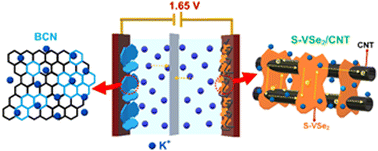Assembling a high-performance asymmetric supercapacitor based on pseudocapacitive S-doped VSe2/CNT hybrid and 2D borocarbonitride nanosheets†
Abstract
The construction of high-performance asymmetric supercapacitors is vital for achieving a sustainable energy storage model. Layered 2D materials are considered pivotal contributing factors to modern-day energy storage solutions. Herein, the electrochemical performance of the S-doped VSe2/CNT positrode and the BCN negatrode is explored for the construction of a compelling aqueous asymmetric supercapacitor. This study provides an understanding of the sulfur doping effects and contributions of CNT addition in the energy storage performance of VSe2. The S doping and CNT addition played a significant role in boosting the pseudocapacitive energy storage performance of metallic VSe2. Borocarbonitride (BCN), which is utilized as a conventional electric double layer material, shows outstanding performance as a negatrode owing to its inherent properties. An asymmetric supercapacitor (ASC) assembled using S-VSe2/CNT and BCN yields a high energy density of 36.3 μW h cm−2 with remarkable reversibility and initial capacitance retention of 87.2% even after 5000 cycles. The remarkable electrochemical performance of S-VSe2/CNT//BCN ASC provides a significant reference for futuristic electronic and energy storage applications.

- This article is part of the themed collection: 1D/2D materials for energy, medicine, and devices


 Please wait while we load your content...
Please wait while we load your content...